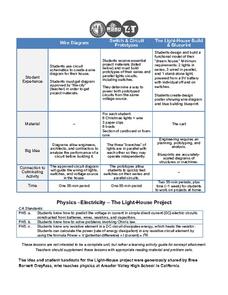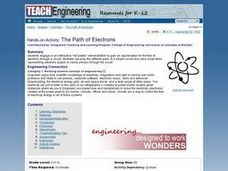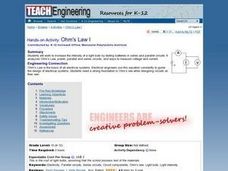Curated OER
WHAT MAKES A LIGHT BULB LIGHT?
Students are able to use inquiry to answer the essential questions. They are able to predict and test configurations of a battery, bulb, and wire that make the complete circuit. Students craft a group and individual theory of a...
Curated OER
Wire Maze
Students investigate what causes electrical circuits to work. They construct a wire circuit and pass a paperclip through the maze, trying not to touch the wire, and answer discussion questions.
Curated OER
Electricity
Students examine basic electrical components. They build a simple electrical circuit which rings a buzzer. They experiment with conducting and nonconducting materials.
Curated OER
Completing the Circuit
Learners use a battery, wires, small light bulb and a light bulb holder to learn the difference between an open circuit and a closed circuit, and understand that electric current only occurs in a closed circuit. They describe the...
Curated OER
Electricity - How it Works and How We Measure and Pay For It
Students investigate energy consumption by researching wattage. In this electricity lesson, students discuss how electricity works and gets transferred to our electronic devices through generators and circuits. Students...
Curated OER
Electric Circuits
Students explore energy by completing an electricity worksheet. In this conductors lesson plan, students define the energy related vocabulary terms circuit, electronics, conductor and semi-conductor before examining computer chips in...
Curated OER
Many Paths
Students explore the composition and practical application of parallel circuitry, compared to series circuitry. They design and build parallel circuits and investigate their characteristics, and apply Ohm's law. They recognize that...
Curated OER
Electricity: Will It Conduct?
Students build conductivity testers and investigate which solids and solutions conduct electricity. Working in groups, they predict which items will conduct electricity and record their answers on worksheets.
Curated OER
How Smart are You about Electricity, Batteries and Conductors?
Students create working circuits. In this electricity and circuits lesson, students make a battery, then build a flashlight and use part of the flashlight to create a conductivity tester.
Trash For Teaching
The Light-House Project
Groups work together to design a lighthouse, from designing and drawing the wiring diagram, to creating prototypes of the switch and circuit, to envisioning and building a scale model along with a blueprint. By including different...
Curated OER
From Sunlight to Electric Current
Students explore concept of current in electrical circuits. They examine how energy from the sun can be used to power everyday items, including vehicles.
Curated OER
Electricity for Kids! It's Shocking!
Students investigate the world of electricity by completing a KWL sheet. In this energy lesson, students view PowerPoint presentations about electricity, who invented it, and how it is used today. Students define several electricity...
Curated OER
The Path of Electrons
Students engage in an interactive "hot potato" demonstration to gain an appreciation for the flow of electrons through a circuit. They role play the different parts of a simple circuit and send small items representing electrons (paper...
Curated OER
Ohm's Law I
Students work to increase the intensity of a light bulb by testing batteries in series and parallel circuits. They analyze Ohm's Law, power, parallel and series circuits, and ways to measure voltage and current.
IOP Institute of Physics
Physics in Concert
What do physicists and musicians have in common? A lot more than you might think. After first viewing a slide show presentation and completing a series of skills practice worksheets on the physics of light, sound, and...
Curated OER
Bulbs & Batteries Side by Side
Students build parallel circuits, exploring how they function and looking at their unique features. They describe how current changes when batteries are added in parallel or removed from a parallel arrangement, demonstrate the process of...
Curated OER
Electrifying the World
Students explore the fundamental concepts of electricity. They examine different circuit diagrams to study how electricity flows. They finish by creating their own simple circuit.
Curated OER
Creating a Simple Telegraph Machine
Students experiment and discuss circuits and how they work. In this science activity, students construct a telegraph machine using cardboard, wires, battery, electric tape and masking tape. They investigate what happens as the circuits...
Curated OER
Two-Cell Battery
Students build their own two-cell battery and determine which electrolyte solution is best suited for making a battery. They discuss background information for their experiment, construct and test their battery, and using the chart on...
Curated OER
The Quest For Power
High schoolers investigate and apply properties of math. In this algebra and physics instructional activity, students define important vocabulary words to create a basic understanding of keywords. They perform experiments using concepts...
Curated OER
TE Activity: Ohm's Law 2
High schoolers study Ohm's Law 2 after completing an activity about Ohm's Law 1. They determine how long it takes to charge a battery. They examine if it is better to use batteries in series or parallel circuits.
Curated OER
Lights On!
Students work together to build their own simple circuits. They discover how electricity is conducted through light bulbs. They compare and contrast the differences beween a parallel and series circuit.
Curated OER
Batteries in Series: Voltage and Light Intensity
Young scholars participate in a hands-on activity to explore the relationship between the number of batteries in a series circuit and its voltage. Students identify the relationship between two variables and plot points on a graph.
Curated OER
TE Lesson: Navigating at the Speed of Satellites
Students study the basic concepts of the Global Positioning System and how it increases the accuracy of navigation. They examine trilateration and how the speed of light is used to calculate distances.























